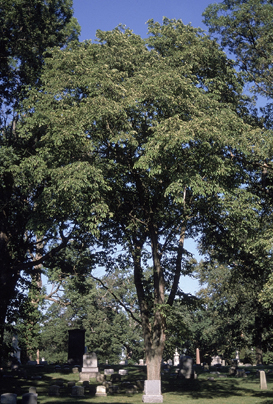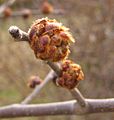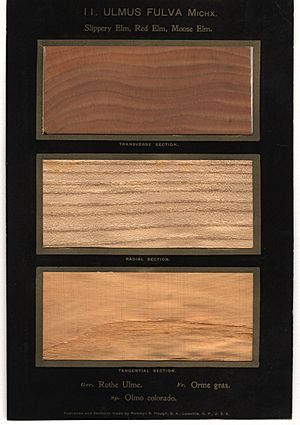Slippery elm facts for kids
Quick facts for kids Slippery elm |
|
|---|---|
 |
|
| A grown-up slippery elm tree | |
| Conservation status | |
| Scientific classification | |
| Genus: |
Ulmus
|
| Species: |
rubra
|
 |
|
| Where Ulmus rubra naturally grows | |
| Synonyms | |
|
|
The slippery elm (scientific name: Ulmus rubra) is a type of elm tree. It grows naturally in eastern North America. You can find it from North Dakota all the way east to Maine and southern Quebec, and south to northern Florida and eastern Texas. It likes damp, higher ground but can also grow in drier soils.
People call this tree by many names, like red elm, gray elm, soft elm, moose elm, and Indian elm. A scientist named Gotthilf Muhlenberg first identified it as its own species, Ulmus rubra, in 1793. Before that, it was thought to be part of the American elm family. Another name, U. fulva, is still used, especially for health products. The slippery elm looks a bit like the American elm. However, it is more closely related to the European wych elm (U. glabra). Slippery elm trees were brought to Europe in 1830.
Contents
What Does the Slippery Elm Look Like?
The slippery elm is a medium-sized deciduous tree, meaning it loses its leaves in the fall. It has branches that spread out wide. Most slippery elms grow to be about 12 to 19 meters (40 to 60 feet) tall. Some can even grow taller than 30 meters (100 feet)!
Its inner wood, called heartwood, is reddish-brown. This is why it's also called the 'red elm'. You can tell it apart from the American elm by its fuzzy twigs and reddish-brown, hairy buds. Its inner bark is also a bit slimy.
Leaves, Flowers, and Fruit
The leaves are large, about 10 to 20 centimeters (4 to 8 inches) long. They feel rough on top but velvety underneath. Their edges are jagged, and they have a pointed tip and a slanted base. The leaf stems are about 6 to 12 millimeters (0.2 to 0.5 inches) long. When the leaves first appear, they often have a red tint. They turn dark green in summer and then a dull yellow in the fall.
The flowers appear in early spring before the leaves. They don't have petals and are pollinated by the wind. They usually grow in small, tight groups of 10 to 20 flowers. The fruit is a reddish-brown, oval-shaped samara. This is a type of winged seed. It's about 12 to 18 millimeters (0.5 to 0.7 inches) long and has a small notch at the top. The single seed inside is covered with reddish-brown hairs.
Tree Health: Pests and Diseases
The slippery elm is thought to be less likely to get Dutch elm disease compared to other American elm trees. However, it can be badly damaged by the elm leaf beetle.
Where Slippery Elms Grow
Slippery elm trees are not often planted for decoration in their home country. In the past, some nurseries in the US sold them. When brought to Europe, they didn't grow very well. For example, a tree planted at Kew Gardens in the UK only reached about 12 meters (40 feet) in 60 years.
Famous Slippery Elm Trees
- In Westmount, Quebec, Canada, there's a tree that measured 4.27 meters (14 feet) around in 2011.
- The largest slippery elm in the US is in Louisville, Kentucky. It's 7.16 meters (23.5 feet) around and 27.4 meters (90 feet) tall. Its branches spread out about 25.18 meters (82.6 feet) wide.
- Another tall tree grows in the Bronx, New York City. It was 31 meters (102 feet) high in 2002.
Slippery Elm Hybrids
In the central United States, the native slippery elm sometimes mixes with the Siberian elm (U. pumila). The Siberian elm was brought to the US in the early 1900s and has spread widely. This mixing worries scientists because it could change the natural slippery elm species.
Hybrid Cultivars
In the 1960s, slippery elm was used to create new types of elm trees by mixing it with other species. Some of these new types include 'Coolshade', 'Fremont', 'Improved Coolshade', 'Lincoln', 'Rosehill', and 'Willis'. Later, it was also used in a tree breeding program at the University of Wisconsin–Madison to create 'Repura' and 'Revera' elms.
Why is it Called "Slippery Elm"?
The scientific name rubra means "red." This refers to the tree's reddish wood. The common name "slippery elm" comes from its inner bark. This bark is mucilaginous, meaning it feels slimy or slippery when wet.
How People Use Slippery Elm
Medicinal Uses
Slippery elm has been used for a long time in traditional medicine. The slimy inner bark of the tree can be eaten. It has been used to soothe sore throats or upset stomachs. The U.S. Food and Drug Administration even approves it for sale as a soothing medicine. Sometimes, people dry the leaves, grind them into a powder, and make them into a tea.
Wood Uses
The wood of the slippery elm is not used a lot in business because there isn't a huge amount of it. However, some people think it lasts longer than other elm woods. It has been suggested for use in things like railway ties, fence posts, and rails. The wood is also good for the hubs of wagon wheels because it can handle a lot of shock. This is because its wood fibers are tightly interlocked. The wood, sometimes called 'red elm', is also used to make bows for archery. The wooden yoke (the curved piece on top) of the Liberty Bell, a famous symbol of American independence, was made from slippery elm.
Baseball History
In the past, some baseball pitchers would chew slippery elm tablets. They did this to make their saliva more effective for throwing a "spitball." This type of pitch was meant to make the baseball curve in an unusual way.
Other Uses
The inner bark of the slippery elm is very strong and can be made into tough fibers. These fibers can be spun into thread, twine, or rope. People have used them for bowstrings, ropes, jewelry, clothing, snowshoe bindings, woven mats, and even some musical instruments. The dried wood is also excellent for starting fires using the bow-drill method. When rubbed, it grinds into a very fine, flammable powder.
Images for kids
See also
 In Spanish: Ulmus rubra para niños
In Spanish: Ulmus rubra para niños











